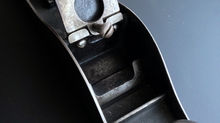And yet another post on hand plane restoration. The great "EVAPO-RUST" debate, (ad-nauseum)
So, off we go once again. Ask 10 people get 10 different answers based on one's personal knowledge and experiences.You are apparently trying to restore and preserve an old relic and there are a lot of ways to to it as evidenced by the myriad of opinions by everyone that's ever done it. Might as well toss in my 2 cents too.
Lotsa ways to destroy or improve the status of an iron and steel hand plane. Some I've seen could not get worse, no matter what you do. Some need nothing other than a gentle cleaning an application of some protective substance to inhibit the degradation that comes with generations of exposure to air and moisture. If you own, or have owned one of these, (or more likely something in the middle), you've probably wondered what to do with it, how to clean it without destroying the classic look, history or value of the tool. Search the web for "hand plane restoration" and you will likely receive dozens of "tried and true methods" all concluding with some pretty amazing results. Some people vehemently defend their method as the "only true process" and you are an idiot if you fail to come around to their way of thinking. (HMMM, sounds like politics these days). Many feel that one should do nothing, not even blow off the sawdust and accumulated shavings save the loss of that one spec that may have been deposited by Bill, they guy who owned it in 1934 and used it to make a dog house for 'ol Sparky. History? YES. Importance? Well, maybe. Rarely do we know the provenance of a hand plane. We can assume they all have one of some type. But so does a used car. Doesn't really make it all that important...except under some circumstances. Who knows, your particular Bailey No 5 type 15 may have once been used by a very young John F. Kennedy in 1932 while he was attending Choate in Wallingford, Connecticut. Probably not. But hey, isn't that pretty close to New Britain? I always try to err on the side of history but a user is probably not going to care about Sparky or JFK as much as he/she is about a reasonably flat bottom and exceptionally sharp iron.
I've used Evaporust, I've used electrolysis, I've used the WD40 razor blade method but I've

never used any type of vinegar, except to clean my coffee maker. IMO, they all have their place in the process but I find that it all depends on the result you are looking for. I can't address the physical or chemical affect that Evaporust may have on the iron but I do know from personal experience that it will remove rust and years of "history", along with any japanning or paint that has been undermined by corrosion.
Others may disagree as their experiences may have been different. I know too, first hand, what it will do to metal if you leave it in too long. I don't know what's in it. I always thought it was a mild citric acid and from my observation of what was left of my neglect sure looked to me to have been dissolved by an acid. But then, I'm no chemist. If you want to see rust form before your very eyes, leave your freshly Evaporusted or electrolysised tool out in the air for 5 minutes. If you wish to avoid that, penetrating oil applied over the surface after it's been rinsed and thoroughly dried, will inhibit the reaction.
If you are looking for a full restoration and plan to remove the old japanning and apply new stuff and use the tool, or if you are just looking for a "newish" look, why not give it a go. "Educate yourself and see what you think. Same with electrolysis, even vinegar if you dare. (I wonder if vinegar and WD40 make a good salad dressing) If you are trying to preserve the "authentically historical" look of the plane try the WD 40/razor blade method, Minimum risk, more effort, controllable results. Experimentation and experience are the best teaching and learning methods. Probably best not to bring your efforts to the attention of the tool restoration groups on Facebook unless you are a masochist. You will likely end up feeling like a frog screw that's been left in Evaporust for 3 days. (It aint pretty)
After 600+ "experiments", I personally like to saturate my restorations in WD 40 + Kroil for a couple days, razor blade the crud off the sides, then gently use a soft abrasive on any bare metal that's showing through the japanning. Just the method I mostly use for the look I mostly want. I don't discount nor advise against either of the other mentioned processes in the proper context. Since I own the plane, I get to do with it as I please despite the disdain it may generate in others who may feel differently.
So, here it is, figuratively and literally THE BOTTOM LINE:
The only way one will EVER know for sure is to try different methods and pick the right one for the goal you are trying to reach and the look that suits you.
OK, more than 2 cents, more like a Nickel, or so I've been told.


































Comments